
The Philippine Coast Guard (PCG) is recognized as the third armed uniformed service of the country attached to the Philippines' Department of Transportation, tasked primarily with enforcing laws within Philippine waters, conducting maritime security operations, safeguarding life and property at sea, and protecting marine environment and resources; similar to coast guard units around the world. In case of a declaration of war, the Coast Guard shall also serve as an attached service of the Department of National Defense.
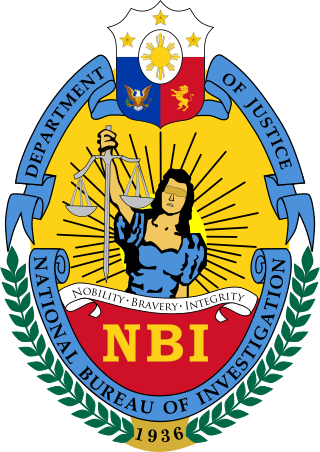
The National Bureau of Investigation is an agency of the Philippine government under the Department of Justice, responsible for handling and solving major high-profile cases that are in the interest of the nation.
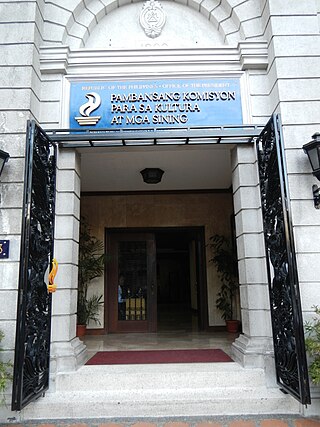
The National Commission for Culture and the Arts of the Philippines is the official government agency for culture in the Philippines. It is the overall policy making body, coordinating, and grants giving agency for the preservation, development and promotion of Philippine arts and culture; an executing agency for the policies it formulates; and task to administering the National Endowment Fund for Culture and the Arts (NEFCA) – fund exclusively for the implementation of culture and arts programs and projects.

The Philippine Atmospheric, Geophysical and Astronomical Services Administration is the National Meteorological and Hydrological Services (NMHS) agency of the Philippines mandated to provide protection against natural calamities and to ensure the safety, well-being and economic security of all the people, and for the promotion of national progress by undertaking scientific and technological services in meteorology, hydrology, climatology, astronomy and other geophysical sciences. Created on December 8, 1972, by reorganizing the Weather Bureau, PAGASA now serves as one of the Scientific and Technological Services Institutes of the Department of Science and Technology.
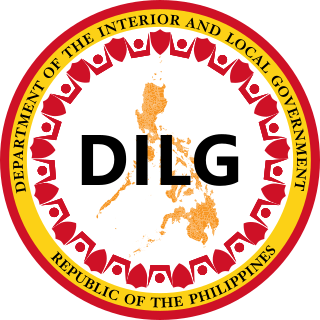
The Department of the Interior and Local Government, abbreviated as DILG, is the executive department of the Philippine government responsible for promoting peace and order, ensuring public safety and strengthening local government capability aimed towards the effective delivery of basic services to the citizenry.

The Presidential Communications Group, or simply the Communications Group, is the collective name for the offices within the Office of the President of the Philippines and refers to the position of the Secretary of Presidential Communications Office formerly known as Office of the Press Secretary and the Secretary of the Presidential Communications Operations Office (PCOO). The office of the presidential spokesperson was previously under the Communications Group.

The Philippines' Bureau of Fisheries and Aquatic Resources, is an agency of the Philippine government under the Department of Agriculture responsible for the development, improvement, law enforcement, management and conservation of the Philippines' fisheries and aquatic resources.

The Philippine Institute of Volcanology and Seismology is a Philippine national institution dedicated to provide information on the activities of volcanoes, earthquakes, and tsunamis, as well as other specialized information and services primarily for the protection of life and property and in support of economic, productivity, and sustainable development. It is one of the service agencies of the Department of Science and Technology.

The National Museum of the Philippines is an umbrella government organization that oversees a number of national museums in the Philippines including ethnographic, anthropological, archaeological, and visual arts collections. From 1973 until 2021, the National Museum served as the regulatory and enforcement agency of the government of the Philippines in the restoring and safeguarding of significant cultural properties, sites, and reservations throughout the Philippines. The mandate has since been transferred to the National Commission for Culture and the Arts.
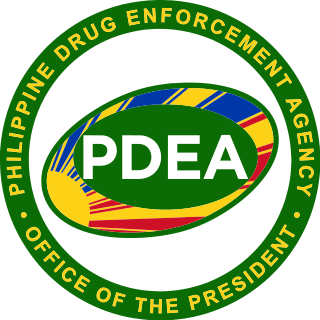
The Philippine Drug Enforcement Agency is the lead anti-drug law enforcement agency, responsible for preventing, investigating and combating any dangerous drugs, controlled precursors and essential chemicals within the Philippines. The agency is tasked with the enforcement of the penal and regulatory provisions of Republic Act No. 9165, otherwise known as the Comprehensive Dangerous Drugs Act of 2002.

The Bureau of Corrections is an agency of the Department of Justice which is charged with the custody and rehabilitation of national offenders, commonly known as Persons Deprived of Liberty or PDL, who have been sentenced to three years of imprisonment or more. The agency has its headquarters in the New Bilibid Prison Reservation in Muntinlupa.

The National Historical Commission of the Philippines is a government agency of the Philippines. Its mission is "the promotion of Philippine history and cultural heritage through research, dissemination, conservation, sites management and heraldry works." As such, it "aims to inculcate awareness and appreciation of the noble deeds and ideals of our heroes and other illustrious Filipinos, to instill pride in the Filipino people and to rekindle the Filipino spirit through the lessons of history."

Jose Ricardo de Leon Manapat was an activist, scholar, writer, researcher, and educator who was the Director of the Records Management and Archives Office of the Philippines from 1996 to 1998 and 2002 to 2008. He is best known as the author of the book, "Some Are Smarter Than Others: The History of Marcos' Crony Capitalism", a work on anti-cronyism exposing the wealth of the Marcos dynasty, and as Editor-in-Chief of the "Smart File", Smart File Magazine Animal Farm Series.

The Office of the President of the Philippines, is an administrative, advisory, and consultative government agency that aids the president of the Philippines in performing their duty as head of state and chief of the executive branch of government.

The Food and Drug Administration (FDA) of the Philippines, formerly the Bureau of Food and Drugs, is a health regulatory agency under the Department of Health created on 1963 by Republic Act No. 3720, amended on 1987 by Executive Order 175 otherwise known as the “Food, Drugs and Devices, and Cosmetics Act”, and subsequently reorganized by Republic Act No. 9711 otherwise known as “The Food and Drug Administration Act of 2009”. The agency is responsible for licensing, monitoring, and regulation of cosmetics, drugs, foods, household hazardous products, medical devices and electromagnetic radiation emitting devices, pesticides, tobacco and related products, and vaccines for safety, efficacy, and quality in the Republic of the Philippines.
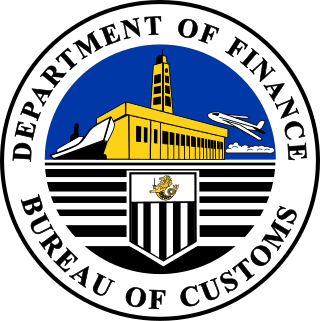
The Bureau of Customs is a Philippine government agency under the Department of Finance. The Bureau of Customs was established on February 6, 1902 by the Insular Government of the Philippine Islands of the United States of America, during the American Colonial Era of the Philippines.
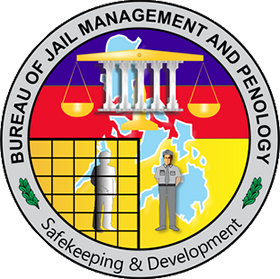
The Bureau of Jail Management and Penology is an attached agency of the Department of the Interior and Local Government mandated to direct, supervise and control the administration and operation of all district, city and municipal jails in the Philippines with pronged tasks of safekeeping and development of its inmates, officially classed as persons deprived of liberty (PDL).

The National Capital Region Police Office (NCRPO) is a division of the Philippine National Police (PNP) that has jurisdiction over Metro Manila, also known as the National Capital Region. It is headquartered in Camp Bagong Diwa.

National Printing Office (NPO) is one of 3 Recognized Government Printers in the Philippines. It was first established in 1901 as the Philippine Bureau of Printing. It is an instrumentality of the Government entrusted with the tasks of printing and binding routine Government publications, public documents, the Official Gazette, and other official forms.

The Bureau of Fire Protection is the government body in the Philippines responsible for the provision of fire services. It is under the jurisdiction of the Department of the Interior and Local Government.




















